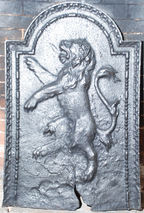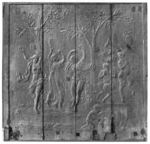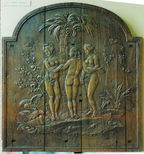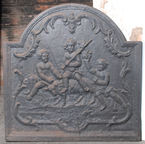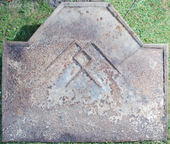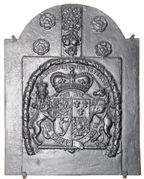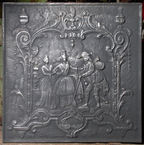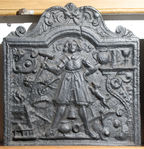-
24
Description: Arched rectangular shaped with fillet and cavetto dentil moulding, and paternost bead edging inside; a lion rampant
Notes: Whole pattern. An unusually tall fireback in relation to its width.
Copies of this fireback are known.
- Decoration tags:
- rectangular with round arch (shape)
- cavetto dentil (edging)
- whole carved pattern
- heraldic
- animals
Manufactured: in the 18th century in England.
Current location: Bateman's, Burwash, East Sussex, England.
Museum number: 761107 (part of the National Trust museum group)
- Attached to series:
- Miscellaneous pattern firebacks
-
935
Description: Carved wooden fireback pattern. Rectangular shape with fillet edging; pictorial scene with three nymphs playing cymbals and tambourine, and dancing in the shade of two trees, with three satyrs play pipes behind; a jug stands on a pedestal; in the foreground a putto fills a jug from a barrel.
Notes: From the Fonderie Salan, Dammarie-sur-Saulx (Meuse).
- Decoration tags:
- rectangular (shape)
- fillet (edging)
- whole carved pattern
- planklines
- pictorial
- mythological
- humans
- plants
Manufactured: in the 18th century in France.
Current location: not known.
- Attached to series:
- Patterns
-
934
Description: Carved wooden fireback pattern. Arched rectangular shape with fillet and astragal edging; pictorial scene of The Three Graces in an exotic rural setting, with a palm tree, roses and ?doves.
Notes: The detail of the carving is very fine
- Decoration tags:
- rectangular with round arch (shape)
- fillet (edging)
- whole carved pattern
- planklines
- pictorial
- mythological
- humans
- plants
- objects
Manufactured: in the 18th century in France.
Current location: Haardplatenmuseum Klarenbeek, Oude Broekstraat 12, Klarenbeek, Netherlands.
- Attached to series:
- Patterns
-
367
Description: Arched rectangular shape; fillet and cavetto moulded edging; pictorial scene of three children, the centre one holding a stick strung with a bunch of grapes over his shoulder, and sitting on a goat.
Notes: A mythological scene of the young Bacchus.
- Decoration tags:
- rectangular with round arch (shape)
- fillet and cavetto (edging)
- whole carved pattern
- pictorial
- mythological
- humans
Manufactured: in the 18th century in France.
Current location: Newarke Houses, Leicester, Leicestershire, England.
Museum number: H.358.1953.0.0 (part of the Leicester City Museums museum group)
Citation: Carpentier, H., 1912, Plaques de Cheminées (Paris, published by the author).
- Attached to series:
- Miscellaneous pattern firebacks
-
465
Description: Rectangular with three-faced arch; ogee moulded edging; top centre, overlapping, crossed staples arranged diagonally, each pointing to a bottom corner.
Notes: The crossed staple is the badge of the Nevill family, and this fireback came from Eridge Park, the seat of the Marquess of Abergavenny.
- Decoration tags:
- rectangular with three-facetted arch (shape)
- cyma reversa/ogee (edging)
- simple stamps
- heraldic
- objects
Manufactured: in the 18th century possibly in the Weald area of England.
Current location: in private hands, Little Horsted, East Sussex, England.
- Attached to series:
- Personal firebacks
- Metalware stamp firebacks
-
535
Description: Arched rectangular shape; no edging; raised central square surmounted by Royal Arms of Great Britain and Ireland, with Garter, crown and lion and unicorn supporters; surrounded by a horseshoe-shaped, twisted floral wreath, within which the inscription is printed in capitals. Above the arms a raised rectangular fillet is surmounted by two suspended floral swags, one above the other, comprising roses and oak apples. On each side of the fillet are two Tudor roses, one above the other.
Notes: Dated to between 1714 and 1801. The inscription is the visible part of an abbreviated version of the formal title of the monarch, ‘By the Grace of God, of Great Britain, France and Ireland, King, Defender of the Faith, Duke of Brunswick and Lünenburg, Arch Treasurer and Prince Elector of the Holy Roman Empire’. Mitford collection, Petworth House.
Copies of this fireback are known.
Inscription: MAG BRIT FRA ET HIB REX F D BRUN ET LUN DUX / HONY SOIT QUI MAL Y PENSE
Arms: English Hanoverian royal
- Decoration tags:
- rectangular with round arch (shape)
- none (edging)
- whole carved pattern
- armorial
- royal
- text
- plants
Manufactured: in the 18th century in England.
Current location: Petworth House, Petworth, West Sussex, England.
Museum number: NT/PET/M/89 (part of the National Trust museum group)
- Attached to series:
- Hanoverian royal armorial firebacks
-
605
Description: Rectangular with ovolo-moulded edging; elaborate symmetrical rococo design framing a pictorial representation of an old man and two young women.
Notes: Carpentier (p.116) ascribes this design to Fontaine's fable of Les Oies de frere Philippe - Brother Philip's Geese.
- Decoration tags:
- rectangular (shape)
- ovolo (edging)
- whole carved pattern
- planklines
- pictorial
- allegorical
- humans
Manufactured: in the 18th century in France.
Current location: Mark Ripley Forge & Fireplaces, Northbridge Street, Robertsbridge, East Sussex, England.
Citation: Carpentier, H., 1912, Plaques de Cheminées (Paris, published by the author).
- Attached to series:
- Miscellaneous pattern firebacks
-
629
Description: Arched rectangular shape with cavetto canted shoulders; wide fillet edging with cavetto moulding inside; within a baroque frame, the seated figure of an old man clasping his cloak, a smoking urn to his left.
Notes: Probably the allegorical figure of Winter.
- Decoration tags:
- rectangular with canted top corners and round arch (shape)
- fillet and cavetto (edging)
- whole carved pattern
- pictorial
- allegorical
- humans
- objects
Manufactured: in the 18th century in France.
Current location: Mark Ripley Forge & Fireplaces, Northbridge Street, Robertsbridge, East Sussex, England.
- Attached to series:
- Miscellaneous pattern firebacks
-
668
Description: Arched rectangular shape with symmetrical floral scrolls on top; three horizontal plank lines; ovolo moulding all round edge of main panel; central figure of a bearded man wearing knee-length coat, belted at waist, and holding a sledge hammer in his right hand, his left arm akimbo; various ‘tools’ of his trade arranged about him; (clockwise from top left) a circular cartouche with a central bead; the date split on either side of his head; a floral console supporting a shelf bearing a flagon, a tankard and a goblet; a circular cartouche with a central bead, a mirrored image of the one in the top left corner; from the top of the cartouche a dog leaping up at its master; between the man’s legs a long-handled ladle, a weight and a cooking pot; a ringer, used to pull slag off molten iron; part of the elevation of a blast furnace, with wooden framework, casting house, and flames issuing from the top; an ore basket, wheelbarrow and a charcoal clamp.
Notes: A pastiche of the 1636 original Lenard fireback (no. 429), now often mistaken for it; the inscription is missing, as are the fireback and the shield each being replaced by a form of cartouche; the figure of the man is more naturalistically modelled, yet wearing similar clothes; his feet face outwards.
Copies of this fireback are known.
Inscription: 1639
- Decoration tags:
- rectangular with round arch (shape)
- ovolo (edging)
- whole carved pattern
- pictorial
- text
- humans
- objects
Manufactured: in the 18th century possibly in the Weald area of England.
Current location: Rottingdean Grange, The Green, Rottingdean, East Sussex, England.
(part of the Brighton Museum museum group)
- Attached to series:
- Miscellaneous pattern firebacks
-
976
 ? x ? mm
? x ? mmDescription: Plain rectangular plate with detached pediment; central shield with motto scroll below.
Notes: The severe classical form suggests that this back may have been intended for attaching to a grate. Blazon: Tynte - Gules, a lion couchant between six cross-crosslets Argent; Kemeys - Vert, on a chevron Argent three pheons Sable.
Inscription: DYW DY RAS
Arms: Tynte quartering Kemeys
- Decoration tags:
- rectangular with detached pediment (shape)
- none (edging)
- whole carved pattern
- armorial
Manufactured: in the 18th century in Wales.
Current location: Cefnmabli, Rudry, Glamorgan, Wales.
- Attached to series:
- Personal armorial firebacks
